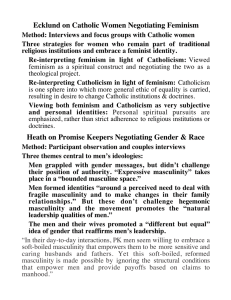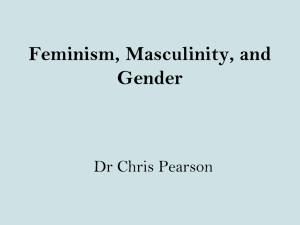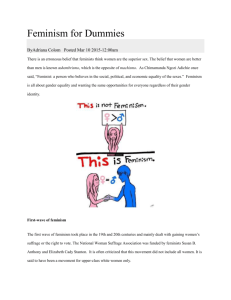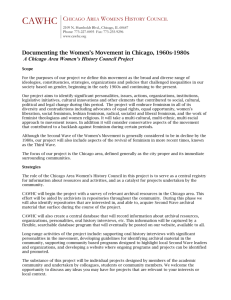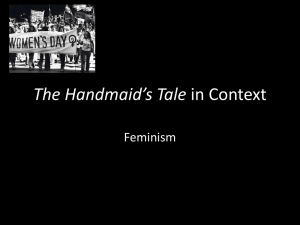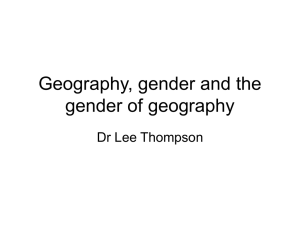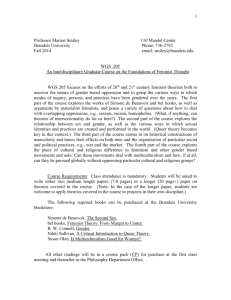INTRODUCTION: What is the relationship between Sex, Gender
advertisement
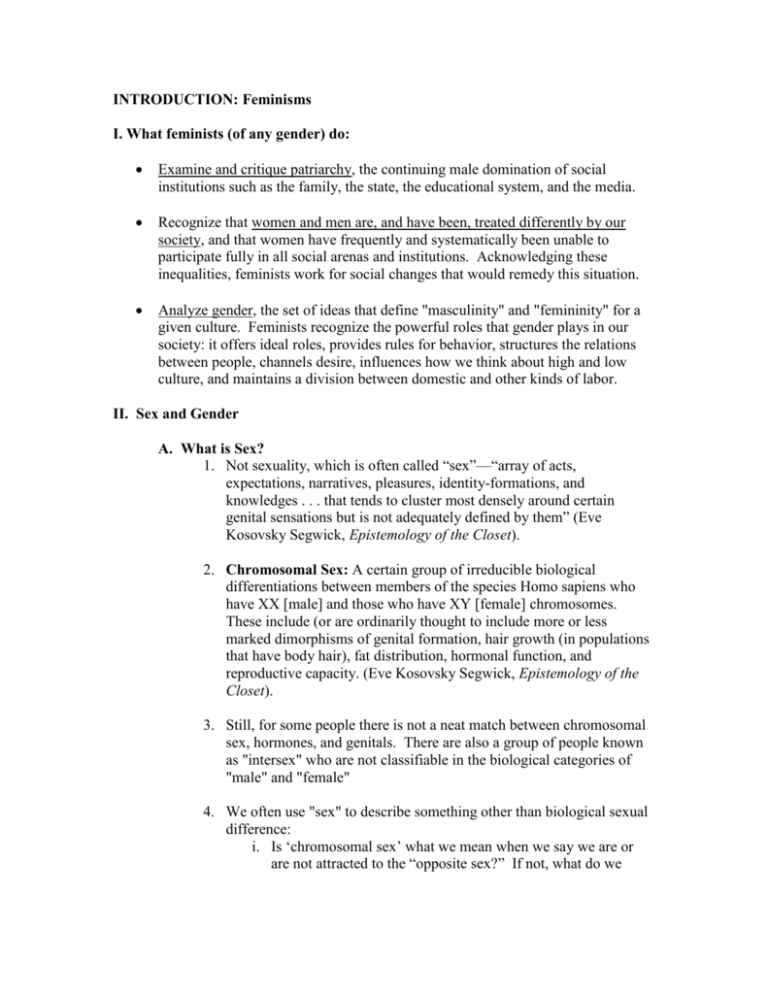
INTRODUCTION: Feminisms I. What feminists (of any gender) do: Examine and critique patriarchy, the continuing male domination of social institutions such as the family, the state, the educational system, and the media. Recognize that women and men are, and have been, treated differently by our society, and that women have frequently and systematically been unable to participate fully in all social arenas and institutions. Acknowledging these inequalities, feminists work for social changes that would remedy this situation. Analyze gender, the set of ideas that define "masculinity" and "femininity" for a given culture. Feminists recognize the powerful roles that gender plays in our society: it offers ideal roles, provides rules for behavior, structures the relations between people, channels desire, influences how we think about high and low culture, and maintains a division between domestic and other kinds of labor. II. Sex and Gender A. What is Sex? 1. Not sexuality, which is often called “sex”—“array of acts, expectations, narratives, pleasures, identity-formations, and knowledges . . . that tends to cluster most densely around certain genital sensations but is not adequately defined by them” (Eve Kosovsky Segwick, Epistemology of the Closet). 2. Chromosomal Sex: A certain group of irreducible biological differentiations between members of the species Homo sapiens who have XX [male] and those who have XY [female] chromosomes. These include (or are ordinarily thought to include more or less marked dimorphisms of genital formation, hair growth (in populations that have body hair), fat distribution, hormonal function, and reproductive capacity. (Eve Kosovsky Segwick, Epistemology of the Closet). 3. Still, for some people there is not a neat match between chromosomal sex, hormones, and genitals. There are also a group of people known as "intersex" who are not classifiable in the biological categories of "male" and "female" 4. We often use "sex" to describe something other than biological sexual difference: i. Is ‘chromosomal sex’ what we mean when we say we are or are not attracted to the “opposite sex?” If not, what do we mean by such statements? Are we still referring to something biological? ii. Is there a natural opposition or difference in status between XX and XY chromosomes? iii. If chromosomes are not visible to the naked eye, how is it that we determine if someone is biologically male or female? B. What is Gender? 1. A social concept by which people are divided into the categories of "masculine" or "feminine." Understood as the cultural articulation of sexual difference, gender plays an immense role in the organization of social and personal life. 2. Gender offers ideal roles, provides rules for behavior, structures the relations between people, channels desire, and maintains a division between domestic and other kinds of labor. 3. Dominant understanding of gender in contemporary Western culture is that it is limited to only two, sometimes complementary, sometimes opposed categories 4. Binary Thinking. Just as a digital computer ultimately sees the world only in terms of binary code, as some combination of zeros or ones, binary systems of knowledge divide the world into two opposed categories. 5. Hierarchy. Result of that division is privileging of one term over the other. In this case privileging masculinity over femininity. 6. Other theories of gender. i. Spectrum. Hegemonic masculinity and femininity may represent two poles and many people fall at many different places. Still keeps fixed idea in place (Bornstein). ii. Female Masculinity. Judith Halberstam points out that there isn't any neat linking between bodies and genders. Lesbian women, for example, have developed their own form of masculinity that is different from "male masculinity." Butchness in the lesbian community is not a copy of male masculinity, but is a kind of masculinity that is distinct to women. iii. Performance. Gender is maintained by the repetition of conventions A way of fitting your body into a pre-existing system of meaning so that others understand how to classify you. This performance can be interrupted or disrupted. C. Gender and Popular Culture 1. Modleski. Not just representations of gender in popular culture. Popular Culture is, itself, a gendered category. High Culture (Art) Masculinity Production Work Intellect Activity Mass Culture (Popular Culture) Femininity Consumption Leisure Emotion Reading 2. High Cutlure critics' fears about role of mass culture in making audiences passive and vulnerable, prone to consumerism is actually a fear of audience becoming feminized. III. Some typologies of feminism A. Historical Waves First Wave. The "first wave" of the feminist movement worked for the reform of women's social and legal inequalities in the nineteenth and early twentieth century. Not all of these women understood themselves as "feminists;" the term was not coined until 1895. Key issues for first wave feminists were education, employment, marriage laws, and the plight of intelligent middle-class single women. The movement was not concerned with the problems faced by workingclass women. Their major achievements included opening access to higher education and professional occupations for women, securing property rights for married women, and securing the right to vote in 1920. Second Wave. Between 1920-1960 there was not a mass movement based in feminist principles. The second wave in the United States was sparked in the late sixties by women participating in the civil rights and anti-war movements. Second wave feminism was a diverse movement, including black feminism, lesbian feminism, liberal feminism, and socialist feminism. One of the most significant ideas from this wave is that "the personal is political," which means that many of the issues impacting women's personal lives (e.g., access to health care, unequal responsibility for housework, sexual harassment in the workplace, sexual assaults and domestic abuse, etc.) should be made public political issues. Women should take political action on these issues and make sure that politicians understand that the problems that affect them aren't just "women's issues" or "personal problems," but are social problems that need to be dealt with. Third Wave. Emerging in the late 1990s, third wave feminism is a youthful movement that accepts the contradictions inherent in struggling against, but still living in a patriarchal society. Third Wavers accept that lives lived in patriarchy will inevitably include compromises and complexity. Instead of "either/or," third wavers more often embrace "both/and." For example, whereas a second-waver might refuse to wear make-up as a way of rejecting patriarchal standards of beauty, a Third Waver would be more likely to simultaneously recognize that wearing make-up in a patriarchal society is connected to imposed ideas of feminine beauty, but at the same time claim the right to wear lipstick for fun. Third wavers build upon the achievements of their predecessors while also making connections with other movements. Kathleen Hanna, lead singer of riot grrrl punk band Bikini Kill and founder of electro-clash band Le Tigre, intimately familiar with domestic violence, and an exstripper, writes: "Resistance is everywhere, it always has been and always will be. Just because someone is not resisting in the same way you are (being a vegan, an 'out' lesbian, a political organizer) does not mean they are not resisting. Being told you are a worthless piece of shit and not believing it is a form of resistance." B. Five Forms of Oppositional Consciousness (from Chela Sandoval's Methodology of the Oppressed) The Equal-Rights Form (e.g., Liberal Feminism) The subordinated group argues for equal rights on the basis that "all humans are created equal." The group argues that any differences between itself and its social superiors are only superficial and shouldn't be used as grounds to deny its members access to social institutions. The Revolutionary Form (e.g., Socialist Feminism) The differences by which the subordinated group is denied access to full humanity cannot simply be assimilated into the existing order. The dominant society must be completely transformed. The goal of this transformation is an egalitarian society in which there are not dominant and subordinate groups. The Supremacist Form (e.g., some forms of Cultural Feminism) The differences (from the dominant group) that define the subordinate group actually give its members access to a higher level of consciousness than those who hold social power. The subordinated group understands itself to be at a higher level of psychic and social evolution (as a result of biology, spirituality, or social conditioning). The Separatist Form (e.g., some forms of mid-70s Lesbian Feminism) The differences that define the subordinated group should be protected and nurtured through complete separation from the dominant social order. This separation may be imagined as permanent or temporary, figurative or literal. The Differential Form (e.g., U.S. Third World Feminism) A post-modern approach that utilizes whichever of the previous four strategies will be most effective at a given moment and in a given context. Rather than seeing the equalrights form, the revolutionary form, the supremacist form, and the separatist form as mutually exclusive ideologies and approaches, the differential form claims that none of them provide a "final answer" to the dismantling of social subordination. Independent movements can and should use their own tactics, but struggle together. Cherie Moraga: "[We] are women without a line. We are women who contradict each other."
